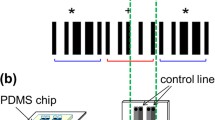Abstract
Biologists frequently collect and analyze biospecimens in naturalistic (i.e., field) conditions to ascertain information regarding the physiological status of their study participants. Generally, field-collected biospecimens need to be stored frozen in the field and then transported frozen to laboratory facilities where traditional biomarker assays, such as enzyme-linked immunosorbent assays (ELISAs), are conducted. As proper storage and transport of frozen specimens is often logistically difficult and expensive, particularly in nonurban field settings, methods that reduce the need for specimen storage and transport would benefit field-research dependent disciplines such as biology, ecology and epidemiology. One limiting factor to running assays in the field is the use of large and expensive equipment to visualize and quantify the assays, such as microplate readers. Here, we describe an implementation of colorimetric ELISA visualization and quantification using two novel and portable imaging instrumentation systems and data processing techniques for the determination of women’s reproductive steroid hormone profiles. Using the light absorbance and transmittance properties of the chemical compounds that make up the hormone assay, we were able to estimate unknown hormone concentrations using a smartphone system and a webcam system. These estimates were comparable to those from a standard laboratory multiple reader (smartphone: accuracy = 82.20%, R 2 > 0.910; webcam: accuracy = 87.59%, R 2 > 0.942). This line of applied research, in the long run, is expected to provide necessary information for examining the extent to which reproductive function varies within and between populations and how it is influenced by psychosocial, energetic and environmental challenges. Our validation of these novel, portable visualization and quantification systems allows for the eventual development of a compact and economical closed system which can be used to quantify biomarker concentrations in remote areas.






Similar content being viewed by others
References
Crowther JR (1995) Methods in molecular biology, Vol 42. ELISA, theory and practice. Humana Press, Totowa
Della Mea V (2001) What is e-health (2): the death of telemedicine? J Med Internet Res 3(2):E22 (PMID: 11720964)
Eysenbach G (2001) What is e-health? J Med Internet Res 3(2):E20 (PMID: 11720962)
Eysenbach G, Diepgen TL (2001) The role of e-health and consumer health informatics for evidence-based patient choice in the 21st century. Clin Dermatol 19(1):11–17 (PMID: 11369478)
Gonzalez RC, Woods RE (2008) Digital image processing. Prentice Hall, Upper Saddle River
Morais CL, Neves ACO, Menezes FG, Lima KMG (2016) Determination of serum protein content using cell phone image analysis. Anal Methods 8:6458–6462
Nepomnaschy PA, Welch K, McConnell D, Strassmann BI, England BG (2004) Stress and female reproductive function: a study of daily variations in cortisol, gonadotrophins, and gonadal steroids in a rural Mayan population. Am J Hum Biol 16:523–532
Nepomnaschy PA, Welch KB, McConnell DS, Low BS, Strassmann BI et al (2006) Cortisol levels and very early pregnancy loss in humans. Proc Natl Acad Sci USA 103:3938–3942
Nepomnaschy PA, Lee TKC, Zeng L, Dean CB (2012) Who is stressed? Methods to appropriately compare cortisol levels between individuals. Am J Hum Biol 24:515–525
O’Connor KA, Brindle E, Holman DJ, Klein NA, Soules MR, Kohen F et al (2003) Urinary estrone conjugate and pregnanediol 3-glucuronide enzyme immunoassay for population research. Clin Chem 49(7):1139–1148
Van Doornik W (2013) Meaningful use of patient-generated data in EHRs. J AHIMA 84(10):30–35
Wang SQ, Zhao X, Khimji I, Akbas R, Qiu W, Edwards D, Cramer DW, Ye B, Demirci U (2011) Integration of cell phone imaging with microchip ELISA to detect ovarian cancer HE4 biomarker in urine at the point-of-care. Lab Chip 11:3411
Acknowledgements
We gratefully acknowledge the funding from the Natural Sciences and Engineering Research Council of Canada (Grant No. 611184), Canadian Institutes of Health Research (Grant No. 106705) and the Michael Smith Foundation for Health Research (Grant No. Career Investigator Scholar award). We also appreciate the support of Ms. Shruti Menon during our experiments.
Author information
Authors and Affiliations
Corresponding author
Glossary
- ELISA
-
Enzyme-linked immunosorbent assay: laboratory test that uses antibodies and changes in intensity of color or fluorescence to quantify the concentration of the target substance, e.g., hormones
- PdG
-
Pregnanediol glucuronide: a urinary metabolite of progesterone
Rights and permissions
About this article
Cite this article
Ogirala, T., Eapen, A., Salvante, K.G. et al. Smartphone-based colorimetric ELISA implementation for determination of women’s reproductive steroid hormone profiles. Med Biol Eng Comput 55, 1735–1741 (2017). https://doi.org/10.1007/s11517-016-1605-7
Received:
Accepted:
Published:
Issue Date:
DOI: https://doi.org/10.1007/s11517-016-1605-7




